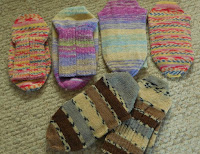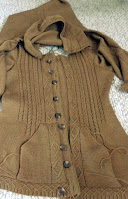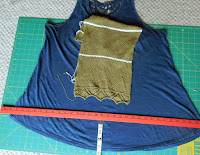Back done, check! I had a starting plan. Was going to still make this a vee neck but not quite as deep as the original. While knitting the Back, had a chat with sister and she indicated that a round neck would suit her fine, so she could wear it with or without a shirt under.
Now that I’m going with a high, round neck, here’s an option – use pins to rough out the new neckline to give a better idea of what will work. After the pins are in place, hold it up to your shoulders and look in the mirror to check how low/high the front neckline will be and adjust if necessary. Here, it’s easy to count back the cables (every 6 rows right) to find your optimum starting row! It will look better if there is at least 2 rows or half the cable before you begin shortrowing/shaping the neckline. Remember, there will be a plain row knit to get rid of the shortrow wraps and maybe another before the actual neckband.
After the agony of fixing that misplaced column of cables, and getting the Back off the machine, I noticed there were only 12 rows before adding in the second columns, and then 18 rows on all the next ones. Duh! I did have it written down – incorrectly, turns out! Fixed that on the Front and did 12 rows on every one, making the chevron nicer – not that anyone will notice! AND, just like I thought, turning the cables to the centre makes no difference – you’d never notice it on the finished garment, provided there were no esses/mistakes!
Safe and happy seasons greetings!











































